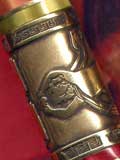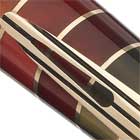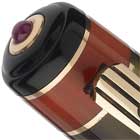 Inspired to the ancient Pompei frescos, found out untouched thank to the Vesuvio eruption
Inspired to the ancient Pompei frescos, found out untouched thank to the Vesuvio eruption 
GENS POMPEIA 

Limited Edition
600 bronze fountain pens
600 bronze rollers
79 gold fountain pens
 Pompei, located nearby Naples, in the south of Italy, was a Greek colony since the VII century B.C., later captured by Etruscans and finally by Romans; it was so named from Gens Pompeia, a Roman family which lived there.
Pompei, located nearby Naples, in the south of Italy, was a Greek colony since the VII century B.C., later captured by Etruscans and finally by Romans; it was so named from Gens Pompeia, a Roman family which lived there.
Pompei was destroyed and completely buried under many meters of ash and pumice on 24 August 79 A.D., during a catastrophic eruption of the volcano Mount Vesuvius, spanning two days; it was lost for nearly 1700 years before its accidental rediscovery in 1748. Since then, its excavation has provided an extraordinarily detailed insight into the life of a city at the time of the Roman Empire.
Today, it is one of the most popular tourist attractions of Italy and a UNESCO World Heritage Site.
The "Pompei Red" colour is well represented in the large pearly resin bands which feature the Gens Pompeia collection.


The large central ring of the barrel is a bronze low-relief work which depicts the famous fresco "Baccants", discovered inside the "Villa del Misteri" of the old ruins of Pompei.



Clip and small rings in brass.
A cabochon red ruby is set at the cap top.
Piston filing system, 14 Kt gold nib, EF, F, M, B.
A more precious version, which has rings and low-relief in solid gold, is produced in only 79 pieces.










